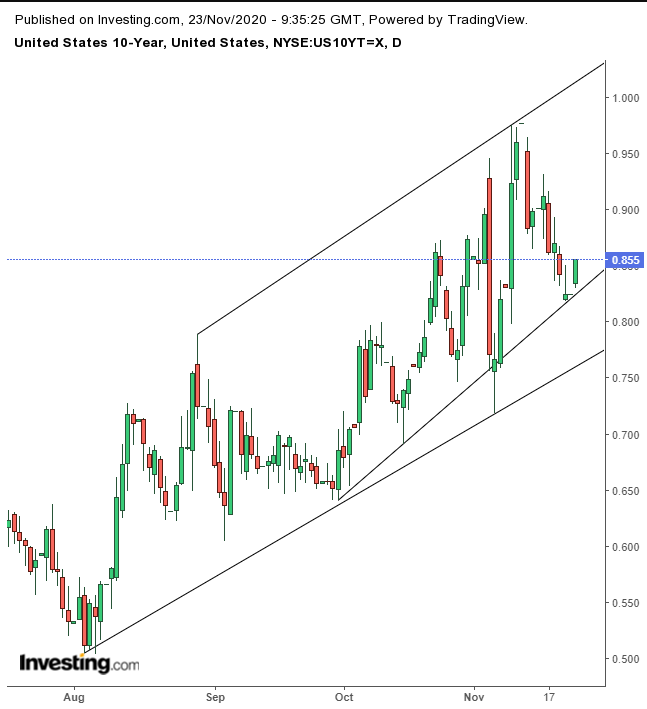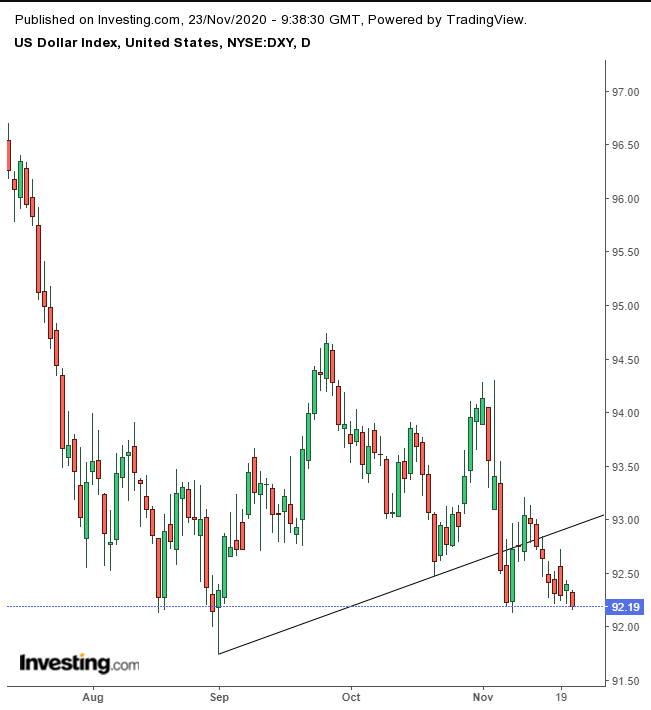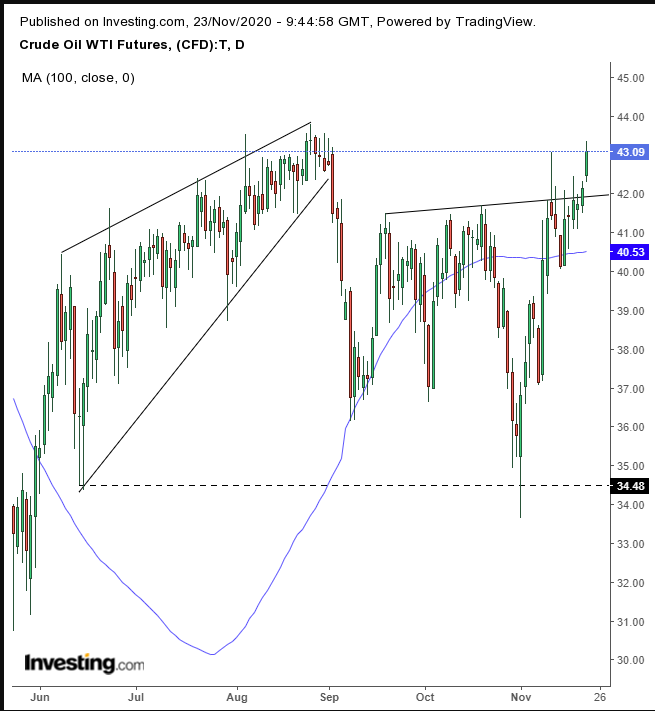- Ironically, even on positive vaccine news, shares of AstraZeneca fell
- The US dollar descends close to its April 2018 low
- Bitcoin hovers at 3-year high
- Minutes of the most recent Federal Open Market Committee meeting are due Wednesday.
- U.S. jobless claims, GDP and personal spending data will be released Wednesday.
- On Wednesday the U.K government will deliver its spending plans for next year.
- The Bank of Korea announces its interest rate policy decision on Thursday.
- The week closes with Black Friday, the traditional start of the US holiday shopping season.
- Futures on the S&P 500 Index increased 0.4%.
- The Stoxx Europe 600 Index gained 1.2%.
- The MSCI Asia Pacific Index gained 0.6%.
- The MSCI Emerging Markets Index increased 1.7%.
- The Dollar Index fell 0.2% to 92.20.
- The euro gained 0.1% to $1.1869.
- The British pound rose 0.6% to $1.3361.
- The Japanese yen strengthened 0.1% to 103.78 per dollar.
- The yield on 10-year Treasuries climbed one basis point to 0.84%.
- The yield on two-year Treasuries dipped less than one basis point to 0.16%.
- Germany’s 10-year yield fell one basis point to -0.58%.
- Britain’s 10-year yield declined less than one basis point to 0.321%.
- West Texas Intermediate crude rose 0.6% to $42.15 a barrel.
- Gold strengthened 0.3% to $1,871.51 an ounce.
Key Events
Global stocks and futures contracts on the Dow, S&P, NASDAQ and Russell 2000 jumped on Monday after AstraZeneca (LON:AZN) announced its potential COVID-19 vaccine prevents an average of 70% of virus cases.
The news enhances the already positive vaccine results from Pfizer (NYSE:PFE) and Moderna (NASDAQ:MRNA) and could reduce the timeframe for the rollout of a global vaccination program.
The increased possibility of an economic recovery at the same time helped drive the price of oil higher. The dollar continued its decline.
Global Financial Affairs
In London, AstraZeneca’s shares fell following its positive news, presumably on the maxim “buy the rumor, sell the news.”
Although all four major US contracts rose at least 0.4%, Russell 2000 futures were the strongest on the continued rotation out of tech shares and into sectors sensative to a re-opening economy as well away from mega caps and into small caps.
In Europe, the Stoxx 600 Index opened higher and continued climbing with the energy and banking sectors outperforming. France's Credit Agricole (PA:CAGR), the world’s largest cooperative financial intuition, opened 2.25% higher and extended gains to 3.7%, the highest since March, on news it agreed to buy Italian lender Credito Valtellinese (MI:PCVI) for 737 million euros, or USD$875 million.
Asian indices were all green, though Japanese markets lost out on the positive mood as they were closed for a holiday. South Korea’s KOSPI outperformed, increasing 1.9%. Hong Kong’s Hang Seng lagged and closed up just 0.1% on renewed US-China tensions.
The White House is moving to restrict 89 Chinese companies it labels "military end-users," such as aerospace as well as other companies, from having access to US goods and technology. At the same time, a high ranking US Navy admiral visited Taiwan—a place China claims as its own—to oversee US military intelligence in the region.
US indices ended lower last week, except for the Russell 2000 which remained in positive territory throughout the week, as reported cases of coronavirus across the globe continued to climb and additional social restrictions were introduced.
Along with the risk-off that decreased appetite for stocks, investors also sold Treasuries.

The selloff caused yields, including on the 10-year Treasury note, to bounce off a short-term uptrend line within a rising channel, confirming Fridays’ inverted hammer.
The dollar slumped for the seventh day out of eight. It fell to the lowest level since Aug. 31. A further slight decline would bring the greenback to its most depressed levels since Apr. 30, 2018.

The USD extended the penetration to a H&S continuation pattern that will ensure a resumption of the underlying downtrend.
Gold declined, but ultimately meandered without a clear path.
Bitcoin almost completely erased Sunday’s dip and, at its current price above $18,500 at time of writing, is hovering at 3-year highs. Still, we would be more comfortable waiting for a substantial correction, before going long.
The news of a third potentially effective vaccine reaffirmed the positive outlook for oil as the end of lockdowns will increase demand.

Still, the price found resistance by the Nov. 11 shooting star, which confirmed the bearishness of the preceding rising wedge. However, the wedge’s implied target might have been achieved on Nov. 2, when it fell to its lowest level. Should that be the case, the current upside move could be a bullish breakout. It all rests on the $44 level. If bulls can overtake it, that would demonstrate they’ve absorbed all of the supply.
